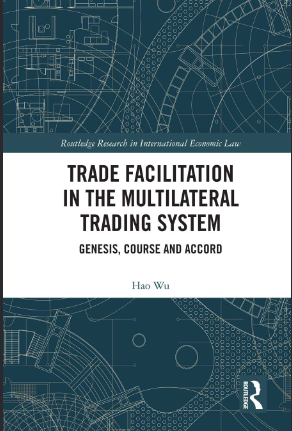he world trading system has truly delivered 1 when the ‘Bali package’ (in par- ticular the Agreement on Trade Facilitation (TFA) therein) was concluded at the ninth Ministerial Conference of the World Trade Organization (WTO) in 2013. 2 The ‘Bali package’ comes at a time when global trade politics is not what it used to be.3 Today’s global trade politics speaks more about dealing with the ‘behind-the-border’ issues than liberalizing tariffs and quotas traditionally ‘at the border’, and in part drives countries to initiate trade talks among ‘preferred’ part- ners rather than within the whole WTO membership. 4 Given that there have been almost 350 preferential trade agreements (PTAs) in force,5 the wave of region- alism, particularly the mega-regional trade initiatives around the Pacific (e.g., Trans-Pacific Partnership (TPP), Regional Comprehensive Economic Partner- ship (RCEP)) and the Atlantic (e.g., Transatlantic Trade and Investment Partner- ship (TTIP)), is hogging the limelight. In contrast, prior to Bali, the stagnation of the Doha Round had tarnished the WTO’s fame of being the prime setting for negotiating trade rules. Indeed, many had despaired of the consensus-seeking global negotiations now and then mired in limbo; some even pessimistically con- ceived of the ‘slow but certain demise’6 of this ‘out of date’7 multilateral regime. After dragging on for more than a slumberous decade, the current round of multilateral trade negotiations, embracing the largest number of participants ever, eventually turned the corner at Bali. Though the ‘Bali package’ is often regarded as a ‘rather modest and partial’ outcome,8 it has, nonetheless, reinstated confidence in the WTO’s negotiating abilities. 9 The Agreement on Trade Facili- tation, as the centerpiece of the ‘Bali package’, thereby becomes the first fully multilateral agreement in the WTO history. In this sense, the significance of the Agreement is far beyond being only an early harvested trade deal in the suspense- ful Doha Round: it heralds that ‘the WTO is back on track’; 10 and it ‘represents rejuvenation of the multilateral trading system’, 11 which ironically should have already fallen down in the General Agreement on Tariffs and Trade (GATT) period according to some bearish forecasts (for example, held by ‘Memorial Drive’ school in the late 1980s)12 but is firmly giving life to the very ideal of multilateralism.13 As part of the WTO rulebook, the Agreement is also epoch- making: it breaks new ground for developing country Members and least devel- oped country (LDC) Members in the way they will implement the Agreemen
چکیده فارسی
نظام تجارت جهانی واقعاً 1 را زمانی که "بسته بالی" (به ویژه توافقنامه تسهیل تجارت (TFA) در نهمین کنفرانس وزیران سازمان تجارت جهانی (WTO) در سال 2013 منعقد شد، ارائه کرد. 2 «بسته بالی» در زمانی ارائه میشود که سیاست تجارت جهانی مانند گذشته نیست.3 سیاست تجارت جهانی امروز بیشتر از آزادسازی تعرفهها و سهمیهها بهطور سنتی در مورد مسائل «پشت مرز» صحبت میکند. مرزی، و تا حدی کشورها را به آغاز گفتگوهای تجاری بین شرکای «مرجح» و نه در کل عضو سازمان تجارت جهانی سوق می دهد. 4 با توجه به اینکه تقریباً 350 موافقت نامه تجارت ترجیحی (PTA) در حال اجرا بوده است، موج منطقه گرایی، به ویژه ابتکارات تجاری کلان منطقه ای در اطراف اقیانوس آرام (به عنوان مثال، مشارکت ترانس پاسیفیک (TPP)، شریک اقتصادی جامع منطقه ای - کشتی (RCEP)) و اقیانوس اطلس (به عنوان مثال، تجارت و سرمایه گذاری ترانس آتلانتیک (TTIP))، در کانون توجه قرار گرفته است. در مقابل، قبل از بالی، رکود دور دوحه، شهرت WTO را به عنوان محیط اصلی برای مذاکره قوانین تجاری مخدوش کرده بود. در واقع، بسیاری از مذاکرات جهانی اجماعجویانه ناامید شده بودند و اکنون در بلاتکلیفی فرو رفتهاند. برخی حتی به طرز بدبینانه ای از «مرگ آهسته اما قطعی»6 این رژیم چندجانبه «منسوخ»7 تصور کردند. پس از به درازا کشیدن بیش از یک دهه خواب آلودگی، دور کنونی مذاکرات تجاری چندجانبه، که بیشترین تعداد شرکت کننده تا کنون را در بر گرفت، در نهایت در بالی پیچید. اگرچه «بسته بالی» اغلب به عنوان یک نتیجه «نسبتاً متوسط و جزئی» در نظر گرفته میشود، اما با این وجود، اعتماد به تواناییهای مذاکره سازمان تجارت جهانی را احیا کرده است. 9 موافقتنامه تسهیل تجارت، به عنوان محور اصلی «بسته بالی»، به این ترتیب اولین توافقنامه کاملاً چندجانبه در تاریخ WTO است. از این نظر، اهمیت توافق بسیار فراتر از این است که فقط یک معامله تجاری زودهنگام در دور معلق دوحه باشد: این خبر میدهد که «سازمان تجارت جهانی به مسیر خود بازگشته است». 10 و «نماینده جوانسازی سیستم تجاری چندجانبه» است، 11 که از قضا باید در دوره موافقتنامه عمومی تعرفهها و تجارت (GATT) طبق برخی پیشبینیهای نزولی (مثلاً توسط مدرسه «Memorial Drive» در در اواخر دهه 1980)12، اما به طور قاطعانه به ایده آل چندجانبه گرایی جان می بخشد.13 به عنوان بخشی از قوانین سازمان تجارت جهانی، این موافقتنامه همچنین دوران ساز است: این توافقنامه زمینه جدیدی را برای کشورهای در حال توسعه و کشورهای کمتر توسعه یافته (LDC) ایجاد می کند. اعضا به روشی که توافقنامه
را اجرا خواهند کرد
ادامه ...
بستن ...
Author(s): Hao Wu
Series: Routledge Research in International Economic Law
Publisher: Routledge, Year: 2018
ISBN: 1138605417,9781138605411
ادامه ...
بستن ...










